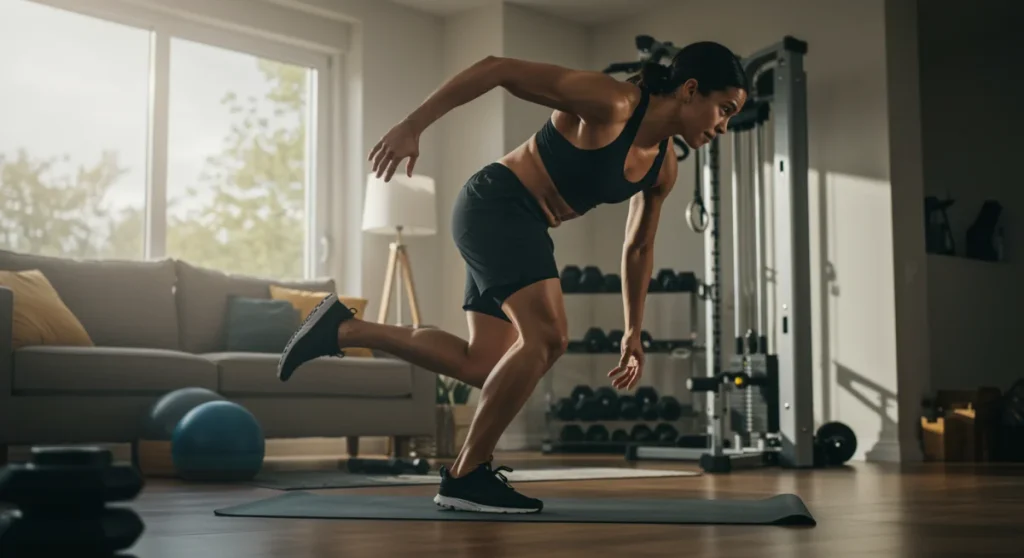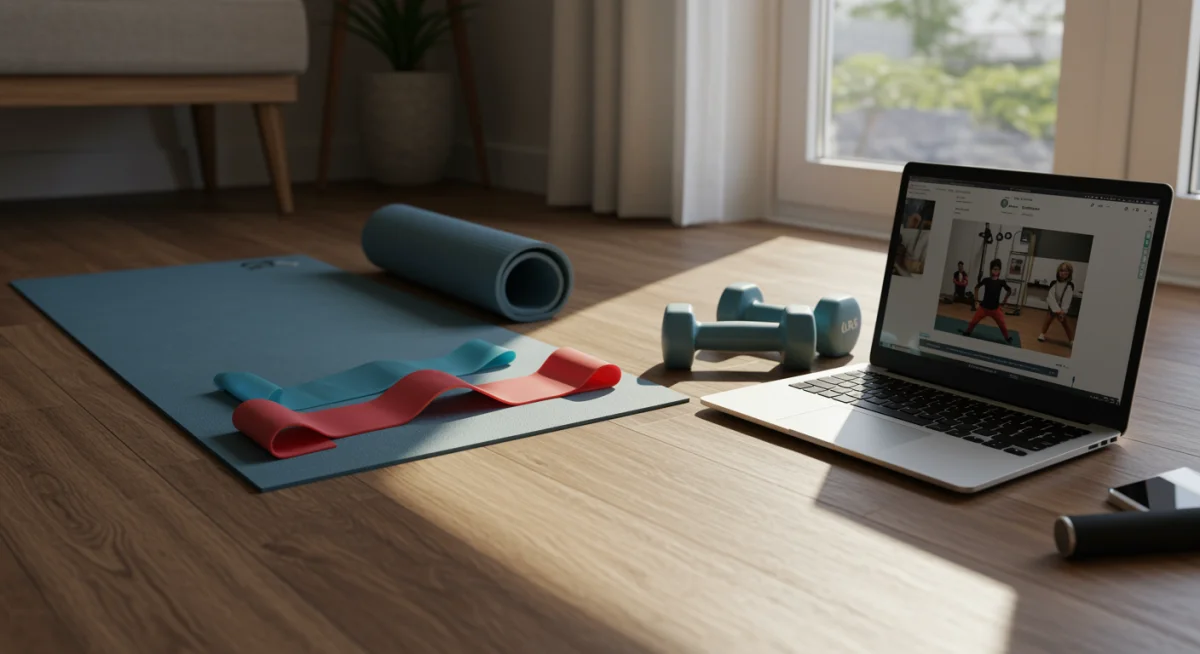Hybrid Fitness Routines: Gym & Home Workouts 2025 Guide

Hybrid fitness routines effectively integrate the best aspects of both gym and home workouts, providing unparalleled flexibility, efficiency, and personalized progress for diverse fitness goals in 2025.
Are you ready to revolutionize your fitness journey? In 2025, hybrid fitness routines are emerging as the ultimate solution for achieving optimal results, seamlessly blending the benefits of gym and home workouts. This comprehensive guide will show you how to combine these two worlds to create a personalized, effective, and sustainable fitness plan.
Understanding the Hybrid Fitness Revolution
Hybrid fitness is more than just a trend; it’s a strategic approach to well-being that acknowledges the demands of modern life. It involves thoughtfully integrating gym-based training with home workouts, leveraging the unique advantages of each environment to create a holistic fitness regimen. This approach allows for greater flexibility, making it easier to stay consistent with your fitness goals regardless of your schedule or access to facilities.
The core concept behind hybrid fitness lies in its adaptability. Instead of committing solely to one type of workout environment, individuals can cherry-pick the best elements from both. For example, a gym might be ideal for heavy lifting or specialized equipment, while home workouts offer convenience for cardio, flexibility, or bodyweight exercises. This blend ensures that you can maintain progress even when time is tight or travel is involved.
The evolution of fitness in 2025
The fitness landscape has evolved significantly, particularly with technological advancements and a greater emphasis on personalized health. In 2025, fitness is less about rigid adherence to a single method and more about smart integration. People are seeking efficient ways to stay active that fit their unique lifestyles, leading to the rise of hybrid models.
- Technological Integration: Wearable tech, smart home gym equipment, and AI-powered apps are making home workouts more engaging and effective.
- Personalized Programs: Customization is key, with routines tailored to individual needs, preferences, and progress.
- Mental Well-being Focus: Fitness is increasingly viewed as a tool for mental health, with hybrid models offering stress reduction through varied activities.
- Community and Connection: Virtual fitness communities and hybrid classes foster a sense of belonging, whether working out alone or with others.
The hybrid fitness revolution is fundamentally about empowering individuals to take control of their health in a way that is both effective and sustainable. It acknowledges that life is unpredictable and provides a robust framework to navigate those uncertainties without sacrificing fitness aspirations. By understanding and embracing this revolution, you can unlock a new level of physical and mental well-being.
Benefits of Combining Gym and Home Workouts
The synergy created by combining gym and home workouts offers a multitude of benefits that extend beyond mere physical conditioning. This hybrid approach addresses common barriers to consistent exercise, such as time constraints, motivation fluctuations, and access to equipment. By strategically blending these two environments, you can optimize your fitness journey for maximum impact and longevity.
One of the most significant advantages is the unparalleled flexibility it provides. Life often throws curveballs, from unexpected work commitments to family responsibilities. A hybrid routine allows you to adapt your workout schedule on the fly, ensuring that you never miss a session. If you can’t make it to the gym, a quick home workout can keep you on track, preventing lapses in consistency that often derail fitness goals.
Enhanced workout variety and progression
Variety is the spice of life, and it’s also crucial for effective fitness. Hybrid training allows you to tap into a wider array of exercises and equipment, preventing plateaus and keeping your body challenged. The gym provides access to heavy weights, specialized machines, and personal trainers, while home offers convenience for bodyweight exercises, yoga, and active recovery.
- Access to diverse equipment: Utilize gym machines for targeted muscle growth and home equipment for functional training.
- Preventing boredom: Switching between environments keeps workouts fresh and engaging, combating monotony.
- Targeted training: Dedicate gym sessions to strength and power, and home sessions to flexibility and endurance.
- Progressive overload: Easily implement progressive overload by leveraging the incremental weight options at the gym, complemented by advanced bodyweight variations at home.
Beyond flexibility and variety, hybrid fitness offers significant cost-effectiveness. While gym memberships can be an investment, they provide access to resources you might not have at home. Conversely, home workouts often require minimal to no equipment, saving money and reducing travel time. This balance makes fitness more accessible and sustainable in the long run. The psychological benefits are also noteworthy, as the ability to choose your workout environment can boost motivation and reduce stress, making exercise a more enjoyable and integrated part of your daily routine.
Designing Your Optimal Hybrid Fitness Schedule
Creating an effective hybrid fitness schedule requires thoughtful planning and an understanding of your personal goals, available resources, and lifestyle. The key is to strike a balance that maximizes the benefits of both gym and home environments while minimizing potential drawbacks. A well-designed schedule ensures consistency, progressive overload, and adequate recovery, all crucial components of optimal results.
Start by assessing your current fitness level and identifying your primary objectives. Are you aiming for muscle gain, weight loss, improved endurance, or overall well-being? Your goals will dictate the type and intensity of workouts you incorporate. Next, consider your weekly availability, including peak times you can dedicate to exercise, and how travel time to the gym factors into your schedule. This initial assessment forms the foundation of your personalized plan.
Strategic allocation of gym vs. home days
The distribution of your gym and home workout days should be strategic. Generally, gym days are best utilized for exercises requiring heavy weights, specialized machines, or the guidance of a trainer. Home days can be dedicated to bodyweight training, cardio, flexibility, or active recovery. This separation allows you to leverage the unique strengths of each setting efficiently.
- Gym days: Focus on compound lifts (squats, deadlifts, bench press), machine-based isolation exercises, and high-intensity interval training (HIIT) that requires ample space or specific equipment.
- Home days: Ideal for bodyweight strength training, yoga, Pilates, cardio (jump rope, running in place), active recovery, and stretching routines.
- Hybrid blend example: Three gym days for strength training, two home days for cardio and flexibility, and two rest days.
When designing your schedule, remember to factor in rest and recovery. Overtraining can lead to burnout and injury, hindering your progress. Incorporate active recovery days, where you engage in light activities like walking or gentle stretching, to aid muscle repair and reduce soreness. Regularly review and adjust your schedule based on your progress, energy levels, and any changes in your lifestyle. A dynamic schedule is a successful schedule, adapting as you evolve in your fitness journey.
Essential Equipment for Home Workouts
While the gym offers a vast array of equipment, a highly effective hybrid fitness routine doesn’t necessitate turning your home into a full-fledged commercial gym. With a strategic selection of essential items, you can create a versatile home workout space that complements your gym sessions. The goal is to choose equipment that provides maximum utility and allows for a wide range of exercises, catering to different muscle groups and fitness goals.
Before purchasing anything, evaluate your available space and budget. You don’t need a dedicated room; a corner of your living room or bedroom can suffice. Prioritize multi-functional items that can be used for various exercises. Investing in quality over quantity will ensure durability and safety, making your home workout experience more enjoyable and effective in the long run.

Must-have items for a versatile home gym
A few key pieces of equipment can significantly enhance your home workout capabilities. These items are relatively inexpensive, compact, and offer a broad spectrum of exercises for strength, cardio, and flexibility.
- Resistance bands: Versatile for strength training, warm-ups, and stretching; available in various resistance levels.
- Dumbbells (adjustable or light/medium set): Essential for strength training, allowing for progressive overload and targeting multiple muscle groups.
- Yoga mat: Provides cushioning and grip for floor exercises, yoga, Pilates, and stretching.
- Jump rope: An excellent, compact tool for cardiovascular conditioning and improving coordination.
- Stability ball: Enhances core strength, balance, and can be used for various exercises to engage stabilizer muscles.
Beyond these essentials, consider incorporating a pull-up bar for upper body strength, or a kettlebell for dynamic movements and functional training. For those looking for a more significant investment, a good quality adjustable bench can expand your exercise repertoire considerably. Remember, the true value of home workout equipment lies in its consistent use. Choose items you enjoy using and that align with your fitness aspirations, ensuring that your home setup genuinely supports your hybrid fitness journey.
Maximizing Your Gym Sessions
While home workouts offer convenience and flexibility, the gym remains an invaluable resource for specific training modalities that are often difficult to replicate at home. To truly optimize your hybrid fitness routines, it’s crucial to approach your gym sessions with purpose and strategy. Maximizing your time at the gym means leveraging its unique offerings to achieve goals that might be challenging to reach with home-based equipment alone.
Before heading to the gym, have a clear plan. Knowing exactly which exercises you’ll perform, the sets, reps, and target weights will save time and ensure a focused workout. This preparation prevents aimless wandering and maximizes the efficiency of your session, allowing you to get the most out of the specialized equipment and environment.
Leveraging specialized equipment and expert guidance
The primary advantage of a gym is its extensive range of equipment, particularly for strength and power training. Utilize barbells, weight machines, and free weights for exercises that require substantial resistance or specific movement patterns. The gym also often provides access to amenities like swimming pools, track areas, or group fitness classes, which can add variety and challenge to your routine.
- Strength training: Focus on compound movements with barbells and heavier dumbbells to build significant muscle mass and strength.
- Machine work: Use isolation machines to target specific muscle groups and ensure proper form, especially for beginners.
- Cardio variety: Explore treadmills, ellipticals, stair climbers, and stationary bikes for diverse cardiovascular workouts.
- Expert advice: Don’t hesitate to consult gym staff or personal trainers for form correction, program design, or spotting for heavy lifts.

Beyond equipment, the gym environment itself can be a powerful motivator. The presence of other individuals pursuing their fitness goals can foster a sense of community and accountability. Additionally, many gyms offer group fitness classes, which can introduce you to new workout styles, provide structured guidance, and add a social element to your routine. By strategically planning your gym sessions to capitalize on these unique benefits, you can ensure that your hybrid fitness approach is truly comprehensive and highly effective.
Nutrition and Recovery in a Hybrid Model
Achieving optimal results with hybrid fitness routines extends beyond just the workouts themselves; it critically involves proper nutrition and adequate recovery. These two pillars are fundamental to supporting muscle growth, enhancing performance, preventing injury, and maintaining overall well-being. Neglecting them can undermine even the most meticulously planned workout schedule, impacting both your physical progress and mental resilience.
Nutrition serves as the fuel for your body, providing the energy needed for intense workouts and the building blocks for muscle repair and growth. A balanced diet rich in lean proteins, complex carbohydrates, healthy fats, vitamins, and minerals is paramount. Hydration is equally vital, as water plays a crucial role in nutrient transport, temperature regulation, and joint lubrication. Tailoring your nutritional intake to match your activity levels – whether it’s a high-intensity gym day or a lighter home workout – is a key component of success.
Optimizing diet and rest for peak performance
Effective recovery is where your body adapts and strengthens in response to the stress of exercise. It’s not just about resting; it involves active strategies to facilitate repair and reduce inflammation. Sleep is perhaps the most critical component of recovery, as it’s during this time that the body repairs tissues, consolidates memories, and regulates hormones essential for physical performance and mental clarity.
- Protein intake: Consume adequate protein (e.g., 0.7-1.0 gram per pound of body weight) to support muscle repair and synthesis, especially after gym sessions.
- Carbohydrate timing: Replenish glycogen stores with complex carbohydrates before and after workouts to maintain energy levels.
- Healthy fats: Include sources of omega-3 fatty acids for their anti-inflammatory properties and overall health benefits.
- Sleep hygiene: Aim for 7-9 hours of quality sleep per night to optimize hormonal balance and muscle recovery.
- Active recovery: Incorporate light activities like walking, stretching, or foam rolling on rest days to improve blood flow and reduce soreness.
Beyond macronutrients, micronutrients obtained from a diverse range of fruits and vegetables are crucial for various bodily functions, including immune support and energy production. Consider consulting with a nutritionist to fine-tune your diet to your specific hybrid routine and fitness goals. By prioritizing both nutrition and recovery, you empower your body to perform at its best, ensuring that every workout, whether at the gym or at home, contributes effectively to your overall health and fitness journey.
Overcoming Challenges and Staying Consistent
Even with the most well-designed hybrid fitness routines, challenges are inevitable. Life happens, and staying consistent can sometimes feel like an uphill battle. However, recognizing potential obstacles and developing strategies to overcome them is crucial for long-term success. The beauty of hybrid fitness lies in its inherent adaptability, providing multiple avenues to maintain your commitment to health and wellness.
One of the biggest hurdles is maintaining motivation. The initial excitement of starting a new routine can wane, especially when faced with busy schedules or plateaus in progress. It’s important to understand that motivation isn’t a constant; it ebbs and flows. Cultivating discipline and building sustainable habits are often more effective than relying solely on bursts of enthusiasm. This means creating routines that are enjoyable and flexible enough to accommodate life’s unpredictability.
Strategies for long-term adherence and motivation
To ensure consistency, it’s beneficial to implement a few key strategies that address common pitfalls. These include setting realistic goals, tracking progress, and finding ways to make fitness an integrated part of your lifestyle rather than a separate chore.
- Set realistic, incremental goals: Break down larger goals into smaller, achievable milestones to maintain momentum and celebrate progress.
- Track your progress: Use a fitness journal or app to record workouts, reps, weights, and personal bests. Seeing tangible progress is a powerful motivator.
- Find an accountability partner: Working out with a friend or joining an online community can provide support and keep you accountable.
- Prioritize rest and nutrition: Adequate recovery and proper fueling prevent burnout and ensure your body is ready for each session.
- Embrace variety: Regularly switch up your workouts (gym vs. home, different exercises) to prevent boredom and keep your body challenged.
- Be flexible: Understand that some days won’t go as planned. Instead of giving up, adapt your workout or schedule a lighter session.
Another common challenge is dealing with temporary setbacks, such as illness or injury. In such cases, it’s vital to listen to your body and adjust your routine accordingly. This might mean taking extra rest days, opting for lower-impact exercises, or focusing on active recovery. The goal is to return to your routine safely and gradually, rather than pushing through pain and risking further injury. By proactively addressing these challenges and embracing flexibility, you can ensure your hybrid fitness journey is both sustainable and incredibly rewarding.
The Future of Fitness: Personalization and Adaptability
As we look beyond 2025, the trajectory of fitness is undeniably heading towards even greater personalization and adaptability, with hybrid models at the forefront. The rigid, one-size-fits-all approach to exercise is fading, replaced by dynamic systems that cater to individual needs, preferences, and evolving lifestyles. This shift is driven by advancements in technology, a deeper understanding of human physiology, and a collective desire for more sustainable and enjoyable health practices.
The concept of hybrid fitness routines perfectly encapsulates this future. It’s not just about combining locations, but about integrating various training methodologies, recovery protocols, and nutritional strategies into a cohesive, individualized plan. This holistic view recognizes that true well-being is multifaceted and requires a flexible approach that can adapt to life’s constant changes. The future will see an even greater emphasis on proactive health management, with fitness playing a central role.
Emerging trends shaping hybrid fitness
Several key trends are set to further solidify the dominance of hybrid fitness in the coming years. These innovations will make personalized fitness more accessible, engaging, and effective for a wider population, democratizing optimal health outcomes.
- AI-powered coaching: Advanced algorithms will analyze performance data, sleep patterns, and even mood to create hyper-personalized workout and nutrition plans that adapt in real-time.
- Gamified fitness: Integrating game-like elements into workouts, both at home and in the gym, to boost motivation and adherence through challenges, rewards, and social interaction.
- Virtual reality (VR) and augmented reality (AR) workouts: Immersive experiences that transport users to diverse environments, making home workouts more engaging and interactive.
- Biometric feedback integration: Wearable devices will offer more sophisticated real-time feedback on heart rate variability, recovery status, and stress levels, allowing for immediate adjustments to training intensity.
- Micro-workouts and active breaks: Acknowledging the demands of busy schedules, future hybrid models will emphasize short, effective bursts of activity throughout the day to combat sedentary lifestyles.
Ultimately, the future of fitness is about empowerment. It’s about giving individuals the tools and flexibility to design a fitness journey that truly fits their lives, not the other way around. Hybrid fitness, with its emphasis on blending environments, technologies, and methodologies, is perfectly positioned to lead this evolution, ensuring that optimal health and well-being are within reach for everyone.
| Key Point | Brief Description |
|---|---|
| Flexibility & Adaptability | Hybrid routines offer unmatched flexibility, allowing workouts to fit any schedule or location, preventing missed sessions. |
| Diverse Training | Combines gym’s specialized equipment for strength with home’s convenience for cardio and bodyweight, enhancing variety. |
| Optimal Recovery | Emphasizes nutrition and sleep as critical components for muscle repair and performance, vital for sustained progress. |
| Future Trends | AI, VR, and biometrics will further personalize hybrid fitness, making it more engaging and effective for everyone. |
Frequently Asked Questions About Hybrid Fitness
A hybrid fitness routine strategically combines workouts performed at a commercial gym with sessions done at home. This approach leverages the unique advantages of both environments, such as specialized gym equipment for strength training and the convenience of home for cardio or bodyweight exercises, creating a flexible and comprehensive fitness plan.
Effective balancing involves assessing your goals and schedule. Dedicate gym days to heavier lifting or machine work, and home days to bodyweight exercises, cardio, or flexibility. Aim for a mix that keeps you challenged and motivated, adjusting based on your energy levels and progress, ensuring consistency is prioritized over strict adherence.
No, you don’t need extensive equipment. Essential items like resistance bands, a yoga mat, and a set of dumbbells can provide a highly effective home workout. The goal is versatility and functionality, allowing you to perform a wide range of exercises that complement your gym sessions without requiring significant space or investment.
Hybrid fitness significantly boosts long-term consistency by offering unparalleled flexibility. When life gets busy or unexpected events occur, you can easily switch your workout location or type, preventing missed sessions. This adaptability reduces barriers to exercise, fostering sustainable habits and making fitness an integrated part of your daily life.
Nutrition and recovery are critical. Proper nutrition fuels workouts and aids muscle repair, while adequate sleep and rest facilitate physical adaptation and prevent burnout. In a hybrid model, these elements are essential for maximizing performance, supporting muscle growth from gym sessions, and ensuring your body is ready for consistent home workouts.
Conclusion
The 2025 guide to hybrid fitness routines underscores a fundamental shift in how we approach health and wellness. By thoughtfully integrating the unique strengths of both gym and home workouts, individuals can forge a fitness path that is not only highly effective but also remarkably flexible and sustainable. This approach empowers you to overcome common barriers to exercise, ensuring consistency and progressive results regardless of life’s demands. Embracing hybrid fitness means investing in a future where your well-being is paramount, adaptable, and continuously evolving to meet your needs.





